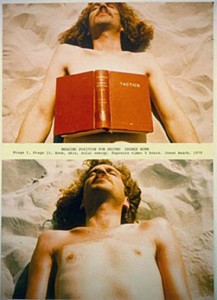Here’s a cool artwork by Heather Ackroyd and Dan Harvey that was featured at the recent Wimbledon tennis-thing. It’s made of three panels of grass.

The sections were grown in a darkened space under artificial lights that projected through photographic negatives. The brighter the exposure, the richer the green color.
It’s the reverse principle at work as leaving a hose or board on your lawn for a week: When you pick up the hose or board you can see how the grass grew pale where it was deprived of sunlight.
So what would you call this art process? It’s basically using light to effect a transformation of some kind of material, and that’s pretty much the definition of photography.
Photography’s first revolution was the ability to use chemical processes to fix an image made by light–think of the photographer disappearing into a darkroom with some unpromising plates or film and coming back with a magical image. Then the physics of turning light sensors into electrical impulses made chemistry-free imaging possible, leading to things like television cameras and your cellphone camera.
And now comes this process where the recording device is biological. Of course, relying on something living and growing, the result is anything but permanent, but that’s also one of the nice things about the pieces. Nothing lasts forever.
The grass artwork reminds me of Dennis Oppenheim’s brilliant 1970 photographic performance, Reading Position for Second Degree Burn, where he leaves a book on his chest as the exposed parts of him sunburn on the beach. The first picture shows him at the beginning, with the book. In the second, hours later with the book removed, a sunburn describes the area where the book protected him.
 Dennis Oppenheim. Reading Position for Second Degree Sunburn. Chromogenic prints with applied text.
Dennis Oppenheim. Reading Position for Second Degree Sunburn. Chromogenic prints with applied text.
It’s just as much a “biological photograph” as the Wimbledon piece. While the grass piece stuns most in its execution, the Oppenheim piece, coming out of conceptual art, buzzes with ideas and humor.
Next time you come back from the beach with untanned patches where your swimsuit shaded your body, why not consider yourself a walking photograph?
[ Thanks to Landscape+Urbanism, where I first saw the Wimbledon grass pieces, and to Creative Review, where I’ve linked. ]
